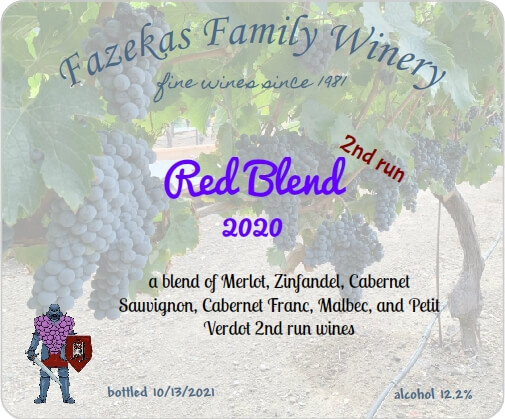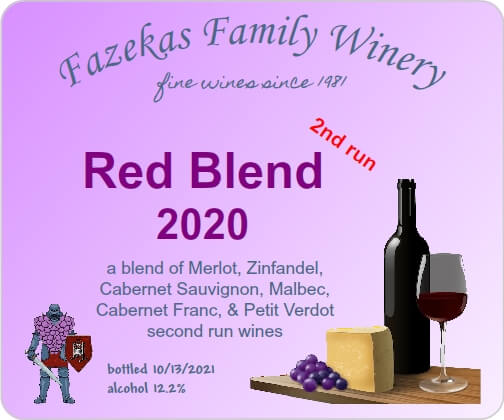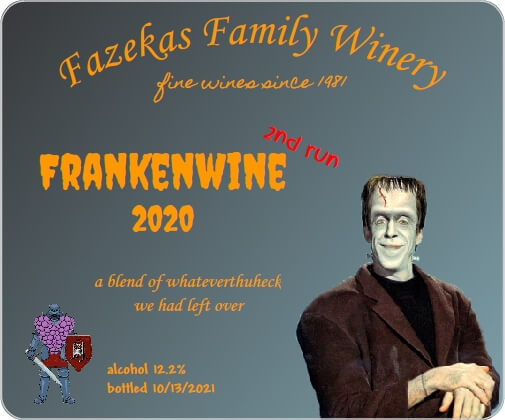2020 Red Blend, 2nd Run
October 2020
Last year’s second run wine is wildly successful, so I’m (of course) doing it again. Making a second run extends my results by 50% AND the cost per bottle was $0.38!
This year I purchased 288 lbs of Merlot (batches 1 and 2), 144 lbs of Zinfandel (batch 3), and 36 lbs each of Cabernet Sauvignon, Cabernet Franc, Malbec, and Petit Verdot (batch 4). Each batch is 144 lbs of grapes. I got 9 to 10 gallons of wine out of each at the pressing, and decided to ferment the 2nd run in the same batches. As I did for the 2019, post-fermentation all will be mixed.
For the two Merlot and the Vinifera Blend I used 5 gallons of water and 10 lbs of sugar. When I got to the Zinfandel, I realized I should have used 4 gallons of water and 8 lbs of sugar for the preceding batches, so I shifted gears. I divided the Zinfandel pomace in 3 and added to the first batches. I’d rather have less wine of a better quality.
We chose to bottle with 3 labels, including a joke label:



Ingredients
| Grape | pomace from 288# Merlot pressed at SG 0.998 (batches 1 & 2) pomace from 144# Vinifera Blend pressed at SG 0.997 (batch 3) pomace from 180# Zinfandel pressed at SG 0.996 |
| Water | 5 gallons hot tap water for each batch |
| Sugar | 10 lbs for each batch |
| Yeast | Red Star Premier Rouge remaining in the pomace |
| Tannin | 2 tsp for each batch |
| Acid Blend | 5 tsp for each batch |
| Fermentation Oak | Merlot + Vinifera Blend has 8 oz French medium toast shredded oak each in the original batch Merlot + Zinfandel has 8 oz American medium toast shredded oak each in the original batch |
| Fermax | 5 tsp in each batch |
| Sulfite | added as needed, see below |
Method
| The same method is used for the pomace from each grape:
Put 1 gallons hot tap water in the fermenter. Added 10 lbs sugar, tannin, acid blend, and Fermax — swirled the fermenter until it was mostly dissolved. Added 1 gallon of host water and swirled until all was dissolved. Added 3 additional gallons of cool tap water. Stirred in pomace. Divided the Zinfandel pomace and distributed among the 3 batches. The SG for the water should be around 1.078. The actual SG is low because the pomace contains wine that is all but fermented out, SG < 1.000. Last year I freaked and added more sugar. This year I’m ignoring the SG. Once the wine ferments out, I’ll calculate SG by averaging 15 gallons with an OG of 1.078 and the OG of however many gallons of wine I get above 15 at the average OG of the original grapes. |
10/20/2020 SG: 1.054 |
| This fermented FAST! Pressed today, putting the wine in 54 liter demijohn and 5 gallon carboy. | 10/24/2020 SG: 1.000 |
| Racked. Discovered I have hydrogen sulfide (H2S2) in the demijohn! The smell is unmistakable, in a very bad way. The carboy and the topup containers are unaffected.
Searched on treatment for H2S, both on the net and WMT. First intervention is to stir hard to drive off gas, then dose with K-meta. Divided wine between 3 primary fermentation buckets. Stirred each for 5 minutes with a drill mounted stirring rod, changing direction every 30 seconds. This drove off a LOT of gas. WARNING: H2S is apparently flammable — I opened all the windows and had a fan running across the buckets. Added triple dose of K-meta (3/4 tsp per 5 gallons) and racked back into demijohn. |
11/21/2020 SG: 0.994 |
| I ordered 30 grams of Reduless, which arrived yesterday. The directions say 0.4 to 0.6 grams dissolved in 6 ml water per gallon of wine. The demijohn is 14 gallons and I went with the middle ground, 0.5 grams, so I need 7 grams. Except I don’t have a scale fine enough to measure. 30 divided by 4 is 7.5, so I divided the package in 4 and added 1 portion.
I siphoned 1 gallon out of the demijohn, added the Reduless, and stirred for 2 minutes, changing direction every 30 seconds. There was some sediment on the bottom, but it was completely distributed, so I figured the Reduless was distributed. This produced a lot of gas, but almost no perceptible H2S smell. Then I poured the reserved gallon back in. |
11/28/2020 SG: 0.994 |
| Fined with Kieselsol & Chitosan. Went to American Brewmaster — they were sold out of SuperKleer, so Mark (owner) went in back and measured out 35 ml Kieselsol & 30 ml chitosan, which is the dosage he looked up for 14 gallons. | 12/02/2020 SG: 0.994 |
| Racked the demijohn. Sediment was less than expected, but a solid layer of a brownish color, presumably the Reduless. Smell is gone, but the wine has a residual flavor that is off. | 12/06/2020 SG: 0.994 |
| Racked both the carboy and the demijohn. Carboy tastes great — I’m guessing this one is from the pomace of the Vinifera Blend, as the Petit Verdot is prominent. The demijohn still has an off flavor.
I decided to proceed with an oak stix experiment. The “good” carboy received 2 oz Hungarian medium toast cubes. Divided the demijohn between 3 carboys, each got one of the American, French, and Hungarian oak stix. The experiment page records the results of taste testing. I will be recording only normal wine making activities in this log. |
02/27/2021 SG: 0.994 |
| Added 3/4 tsp ascorbic acid to the 3 carboys of wine that experience H2S. This is supposed to handle some of the potential off flavors. According to calculations, each carboy can handle up to 1-1/4 tsp, but I went light as the ascorbic can jack up the acid content. | 04/20/2021 SG 0.994 |
| Racked all carboys. Added 1/4 tsp K-meta and 5 oz glycerin to each carboy. Bottled the oak cubes by itself. Blended the three stix carboys as the blended flavors were better. Bottled. | 10/13/2021 SG 0.994 |
Notes
| Yield | 101 bottles |
| Alcohol | 12.2% |
| 10/27/2021 | Tasted the stix blended wine last night — the color is nice, not inky, but a bright reddish-purple. The flavor is more like a dark rose.
Tasted the cubes wine today when cooking. It’s a bit darker and more reddish, and has nice fruit tones. The wine is improved by aeration — the tannins are not heavy at all, but the aeration rounds out the wine. |
| 10/07/2021 | The stix wine has a light taste, overall, with fruit standing out. There is a tannin astringency on the aftertaste that finishes it nicely. I’m going to be sad when this one is all gone. |
